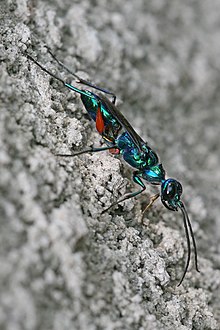Emerald cockroach wasp
From Wikipedia, the free encyclopedia
| Emerald cockroach wasp | ||||||||||||||||||
|---|---|---|---|---|---|---|---|---|---|---|---|---|---|---|---|---|---|---|
 Ampulex compressa
|
||||||||||||||||||
| Scientific classification | ||||||||||||||||||
|
||||||||||||||||||
| Binomial name | ||||||||||||||||||
| Ampulex compressa (Fabricius, 1781) |
The emerald cockroach wasp or jewel wasp (Ampulex compressa) is a solitary wasp of the family Ampulicidae. It is known for its unusual reproductive behavior, which involves disabling a live cockroach and using it as a host for its larvae. It thus belongs to the entomophagous parasites.
Contents |
[edit] Distribution
The wasp is common in the tropical regions of South Asia, Africa and the Pacific islands. The flying wasps are more abundant in the warm seasons of the year.
A. compressa was introduced to Hawaii by F. X. Williams in 1941 as a method of biocontrol. This has been unsuccessful because of the territorial tendencies of the wasp, and the small scale on which they hunt.[1]
[edit] Appearance
The wasp has a metallic blue-green body, with the thighs of the second and third pair of legs red. The female is about 22 mm long; the male is smaller and lacks a stinger.[1]
[edit] Reproductive behavior and life cycle
As early as the 1940s it was reported that female wasps of this species sting a roach (specificially a Periplaneta americana, Periplaneta australasiae or Nauphoeta rhombifolia[1]) twice, delivering venom. A 2003 study[2] proved using radioactive labeling that the wasp stings precisely into specific ganglia of the roach. She delivers an initial sting to a thoracic ganglion and injects venom to mildly and reversibly paralyze the front legs of the insect. This facilitates the second venomous sting at a carefully chosen spot in the roach's head ganglia (brain), in the section that controls the escape reflex. As a result of this sting, the roach will first groom extensively, and then become sluggish and fail to show normal escape responses.[3] In 2007 it was reported that the venom of the wasp blocks receptors for the neurotransmitter octopamine.[4]
The wasp proceeds to chew off half of each of the roach's antennae.[1] The wasp, which is too small to carry the roach, then leads the victim to the wasp's burrow, by pulling one of the roach's antennae in a manner similar to a leash. Once they reach the burrow, the wasp lays a white egg, about 2 mm long, on the roach's abdomen. It then exits and proceeds to fill in the burrow entrance with pebbles, more to keep other predators out than to keep the roach in.
With its escape reflex disabled, the stung roach will simply rest in the burrow as the wasp's egg hatches after about three days. The hatched larva lives and feeds for 4-5 days on the roach, then chews its way into its abdomen and proceeds to live as an endoparasitoid. Over a period of eight days, the wasp larva consumes the roach's internal organs in an order which guarantees that the roach will stay alive, at least until the larva enters the pupal stage and forms a cocoon inside the roach's body. Eventually the fully-grown wasp emerges from the roach's body to begin its adult life. Development is faster in the warm season.
Adults live for several months. Mating takes about one minute, and only one mating is necessary for a female wasp to successfully parasitize several dozen roaches.
While a number of venomous animals paralyze prey as live food for their young, Ampulex compressa is different in that it initially leaves the roach mobile and modifies its behavior in a unique way. Several other species of the genus Ampulex show a similar behavior of preying on cockroaches.[1] The wasp's predation appears only to affect the cockroach's escape responses. Research has shown that while a stung roach exhibits drastically reduced survival instincts (such as swimming, or avoiding pain) for approximately 72 hours, motor abilities like flight or flipping over are unimpaired.[5][6]
[edit] References
- ^ a b c d e Williams, F. X. (1942) "Ampulex compressa (Fabr.), a cockroach-hunting wasp introduced from New Caledonia into Hawaii". Proc. Hawaiian Entomological Society, 11:221–233.
- ^ *Gal Haspel, Lior Ann Rosenberg & Frederic Libersat (2003): Direct Injection of Venom by a Predatory Wasp into Cockroach Brain, Journal of Neurobiology, 56 (4):287-292 doi:10.1002/neu.10238
- ^ Gal, Ram; Rosenberg, Lior Ann; Libersat, Frederic (22 November 2005). "Parasitoid wasp uses a venom cocktail injected into the brain to manipulate the behavior and metabolism of its cockroach prey". Archives of Insect Biochemistry and Physiology 60 (4): 198–208. doi:. http://www3.interscience.wiley.com/journal/112152224/abstract.
- ^ How to make a zombie cockroach, Nature News, 29 September 2007
- ^ Yong, Ed (June 5, 2008). "The wasp that walks cockroaches". Not Exactly Rocket Science News. http://scienceblogs.com/notrocketscience/2008/06/the_wasp_that_walks_cockroaches.php. Retrieved on 2008-07-14.
- ^ Libersat, Frederic (June 27, 2003). "Wasp uses venom cocktail to manipulate the behavior of its cockroach prey" (PDF). Journal of Comparative Physiology (Springer-Verlag) 189. http://www.bgu.ac.il/life/Faculty/Libersat/pdf/JCP.2003.pdf.
[edit] See also
- Glyptapanteles, a genus of wasp capable of inducing caterpillars to guard its pupae.
- Hymenoepimecis argyraphaga, a species of wasp that affects the web-building behavior of spiders to its own ends.
- Tarantula hawk
[edit] External links
| Wikispecies has information related to: Ampulex compressa |
- Video of the Emerald Cockroach Wasp's full lifecycle
- Images of Emerald Cockroach Wasps, from MorphBank biological image database

